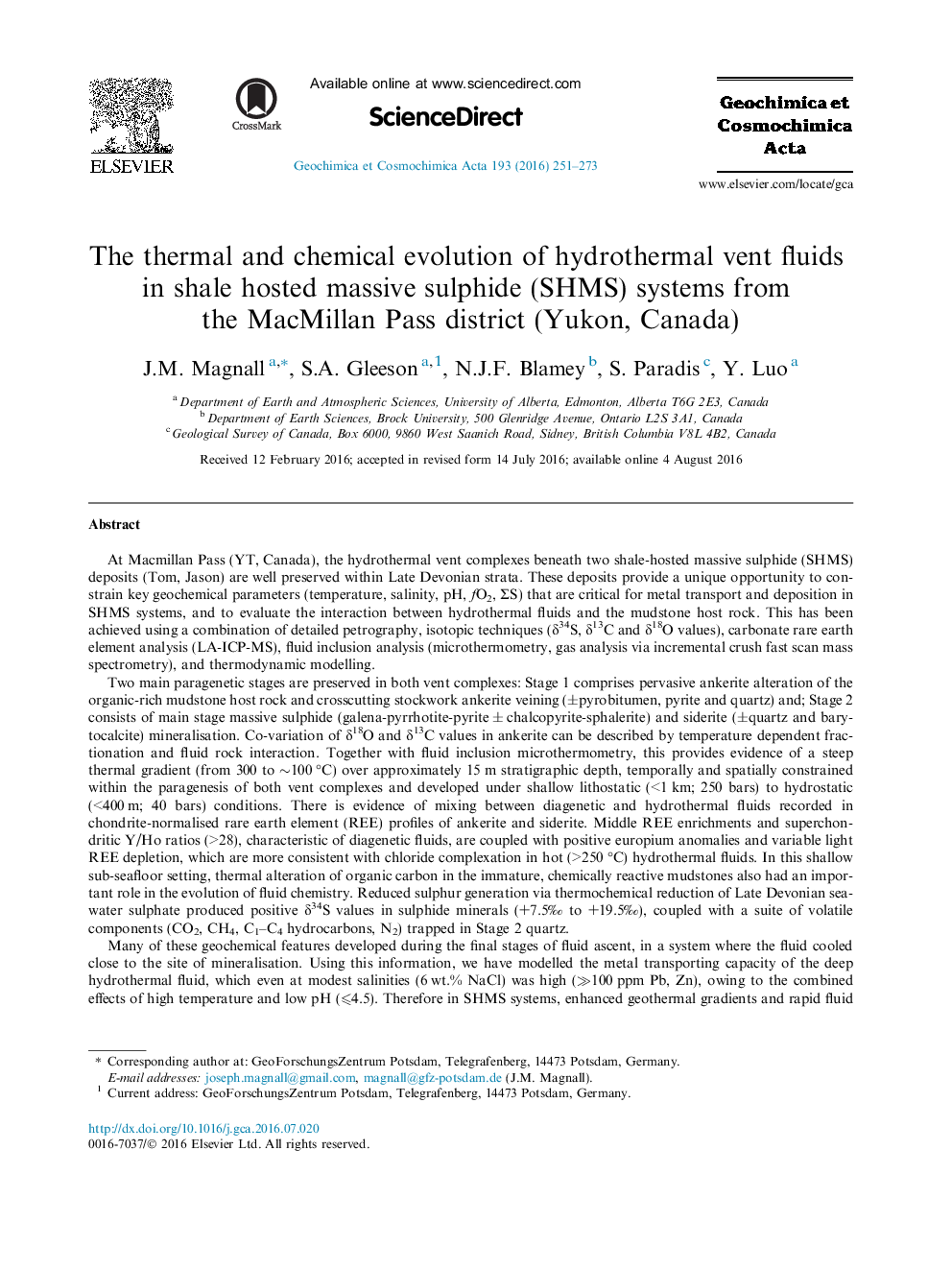| کد مقاله | کد نشریه | سال انتشار | مقاله انگلیسی | نسخه تمام متن |
|---|---|---|---|---|
| 6437145 | 1637964 | 2016 | 23 صفحه PDF | دانلود رایگان |

At Macmillan Pass (YT, Canada), the hydrothermal vent complexes beneath two shale-hosted massive sulphide (SHMS) deposits (Tom, Jason) are well preserved within Late Devonian strata. These deposits provide a unique opportunity to constrain key geochemical parameters (temperature, salinity, pH, fO2, ΣS) that are critical for metal transport and deposition in SHMS systems, and to evaluate the interaction between hydrothermal fluids and the mudstone host rock. This has been achieved using a combination of detailed petrography, isotopic techniques (δ34S, δ13C and δ18O values), carbonate rare earth element analysis (LA-ICP-MS), fluid inclusion analysis (microthermometry, gas analysis via incremental crush fast scan mass spectrometry), and thermodynamic modelling.Two main paragenetic stages are preserved in both vent complexes: Stage 1 comprises pervasive ankerite alteration of the organic-rich mudstone host rock and crosscutting stockwork ankerite veining (±pyrobitumen, pyrite and quartz) and; Stage 2 consists of main stage massive sulphide (galena-pyrrhotite-pyrite ± chalcopyrite-sphalerite) and siderite (±quartz and barytocalcite) mineralisation. Co-variation of δ18O and δ13C values in ankerite can be described by temperature dependent fractionation and fluid rock interaction. Together with fluid inclusion microthermometry, this provides evidence of a steep thermal gradient (from 300 to â¼100 °C) over approximately 15 m stratigraphic depth, temporally and spatially constrained within the paragenesis of both vent complexes and developed under shallow lithostatic (<1 km; 250 bars) to hydrostatic (<400 m; 40 bars) conditions. There is evidence of mixing between diagenetic and hydrothermal fluids recorded in chondrite-normalised rare earth element (REE) profiles of ankerite and siderite. Middle REE enrichments and superchondritic Y/Ho ratios (>28), characteristic of diagenetic fluids, are coupled with positive europium anomalies and variable light REE depletion, which are more consistent with chloride complexation in hot (>250 °C) hydrothermal fluids. In this shallow sub-seafloor setting, thermal alteration of organic carbon in the immature, chemically reactive mudstones also had an important role in the evolution of fluid chemistry. Reduced sulphur generation via thermochemical reduction of Late Devonian seawater sulphate produced positive δ34S values in sulphide minerals (+7.5â° to +19.5â°), coupled with a suite of volatile components (CO2, CH4, C1-C4 hydrocarbons, N2) trapped in Stage 2 quartz.Many of these geochemical features developed during the final stages of fluid ascent, in a system where the fluid cooled close to the site of mineralisation. Using this information, we have modelled the metal transporting capacity of the deep hydrothermal fluid, which even at modest salinities (6 wt.% NaCl) was high (â«100 ppm Pb, Zn), owing to the combined effects of high temperature and low pH (⩽4.5). Therefore in SHMS systems, enhanced geothermal gradients and rapid fluid ascent (with minimal fluid cooling) are considered to be the most important factors for transporting high concentrations of base metals to the site of mineralisation.
Journal: Geochimica et Cosmochimica Acta - Volume 193, 15 November 2016, Pages 251-273